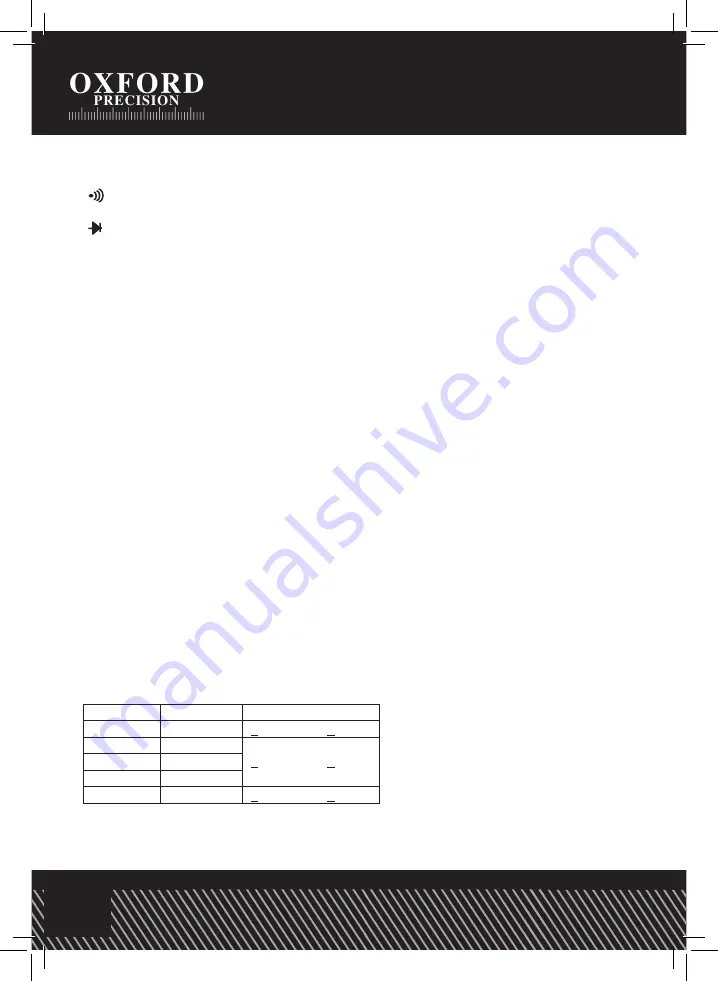
4
SYMBOLS AND ANNUNCIATORS
RESISTANCE MEASUREMENTS
WARNING: To avoid electric shock, disconnect power to the unit
under test and discharge all capacitors before taking any resistance
measurements. Remove the batteries and unplug the line cords.
1. Set the function switch to the
Ω
position.
2. Insert the black test lead banana plug into the negative (COM) jack
and the red test lead banana plug into the positive
Ω
jack.
3. Touch the test probe tips across the circuit or part under test. It is best
to disconnect one side of the part under test so the rest of the circuit
will not interfere with the resistance reading.
4. Read the resistance in the display. The display will indicate the proper
decimal point, value and symbol.
CONTINUITY CHECK
WARNING: To avoid electric shock, never measure continuity on
circuits or wires that have voltage on them.
1.
Set the function switch to the position.
2.
Insert the black lead banana plug into the negative (-) jack (COM)
and the red test lead banana plug into the positive (+) jack (
Ω
).
3.
Press the button until the symbol appears in the display.
4.
Touch the test probe tips to the circuit or wire you wish to check.
5.
If the resistance is less than approximately 150
Ω
, the audible signal
Continuity
BAT
Low Battery
RESISTANCE MEASUREMENTS
WARNING: To avoid electric shock, disconnect power to the unit
under test and discharge all capacitors before taking any resistance
measurements. Remove the batteries and unplug the line cords.
1. Set the function switch to the
Ω
position.
2. Insert the black test lead banana plug into the negative (COM) jack
and the red test lead banana plug into the positive
Ω
jack.
3. Touch the test probe tips across the circuit or part under test. It is best
to disconnect one side of the part under test so the rest of the circuit
will not interfere with the resistance reading.
4. Read the resistance in the display. The display will indicate the proper
decimal point, value and symbol.
CONTINUITY CHECK
WARNING: To avoid electric shock, never measure continuity on
circuits or wires that have voltage on them.
1.
Set the function switch to the position.
2.
Insert the black lead banana plug into the negative (-) jack (COM)
and the red test lead banana plug into the positive (+) jack (
Ω
).
3.
Press the button until the symbol appears in the display.
4.
Touch the test probe tips to the circuit or wire you wish to check.
5.
If the resistance is less than approximately 150
Ω
, the audible signal
Diode
DATA HOLD
Data Hold
AUTO
Auto Ranging
AC
Alternating Current or Voltage
DC
Direct Current or Voltage
SPECIFICATIONS
The instrument
complies with:
EN61010-1
Insulation:
Class2, Double insulation
Over voltage category:
CAT III 1000V, CAT IV 600V
Display:
4000 counts LCD display with function indication
Polarity:
Automatic, (-) negative polarity indication
Over range:
“OL” mark indication
Low battery indication:
The “BAT” is displayed when the battery voltage drops
below the operating level
Measurement rate:
2 times per second, nominal
Auto power off:
Meter automatically shuts down after approx.
15 minutes of inactivity
Operating environment:
0°C to 50°C (32 °F to 122 °F) at
<70 % relative humidity
Storage temperature:
-20 °C to 60 °C (-4 °F to 140 °F) at
< 80 % relative humidity
For inside use, max height:
2000m
Pollution degree:
2
Power:
One 9V battery, NEDA 1604, IEC 6F22
Dimensions:
182 (H) x 82 (W) x55 (D) mm
Weight: Approx.:
375g
Accuracy is given at 18 °C to 28 °C (65 °F to 83 °F), less than 70 % RH
DC Voltage (Auto ranging)
Input Impedance: 7.8M
Ω
Maximum Input: 1000V DC or 1000V AC rms
Weight: Approx.: 375g.
Accuracy is given at 18 oC to 28 oC (65 oF to 83 oF), less than
70 % RH
DC Voltage (Auto-ranging)
Range
Resolution
Accuracy
400.0mV
0.1mV
+0.5% of rdg + 2 dgts
4.000V
1mV
+1.2% of rdg + 2 dgts
40.00V
10mV
400.0V
100mV
1000V
1V
+1.5% of rdg + 2 dgts
Input Impedance: 7.8M
Ω
.
Maximum Input:1000V dc or1000V ac rms.
AC Voltage (Auto-ranging except 400mV)
Range
Resoluti
on
Accuracy
400.0mV
0.1mV
+1.5%of rdg + 70 dgts
4.000V
1mV
+1.2% of rdg + 3 dgts
40.00V
10mV
+1.5% of rdg + 3 dgts
400.0V
100mV
1000V
1V
+2.0% of rdg + 4 dgts
Input Impedance: 7.8M
Ω
.
AC Response: 50 Hz to 400 Hz
Maximum Input: 1000V dc or 1000V ac rms.






























